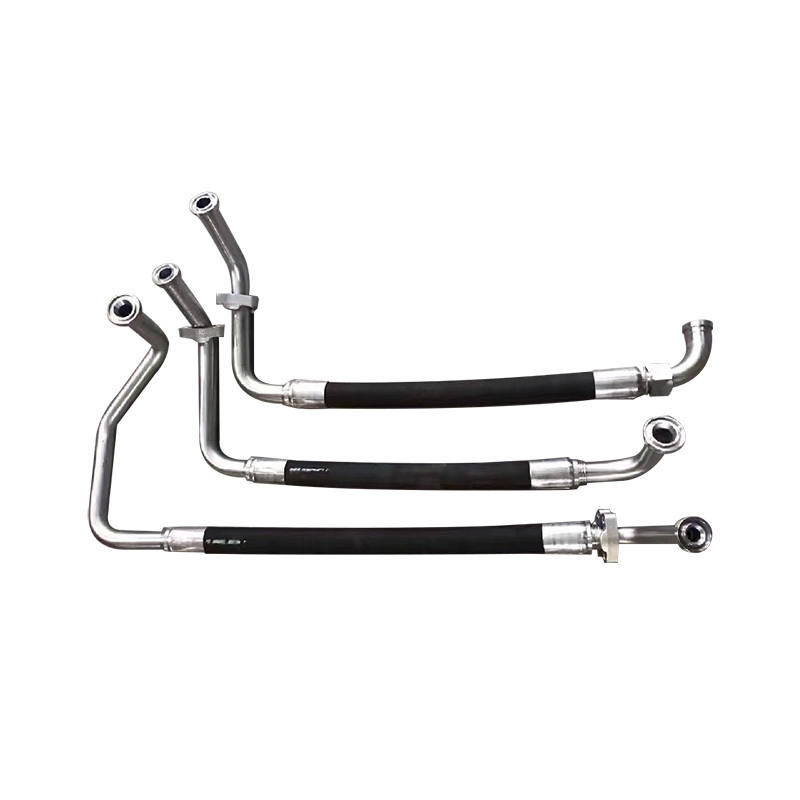Products
Contact us
Phone: +86-18732861678
WhatsApp: +8613676932567
Fotai, Duqiao Town, Jing County, Hengshui City, Hebei Province, China
Rubber flexible connector
- 产品描述
-
Rubber flexible connectors, also known as rubber expansion joints, flexible rubber joints, resilient rubber joints, rubber shock absorbers, etc., are pipe joints with high elasticity, high airtightness, medium resistance, and weather resistance. The following is a detailed introduction to rubber flexible connectors:
Structure Composition
Rubber flexible connectors are mainly composed of inner and outer rubber layers, a cord fabric layer, and steel wire rings, forming a tubular rubber part. After high-temperature and high-pressure vulcanization molding, they are loosely assembled with metal flanges. Among these, the rubber sphere is the core part, and common materials include natural rubber, nitrile rubber, EPDM rubber, etc., each with different characteristics to adapt to various working environments. Metal flanges are generally made of carbon steel or stainless steel and are tightly combined with the rubber sphere through a vulcanization process.
Classification
Rubber flexible connectors can be classified according to different standards:
1. Classified by external shape: including single sphere rubber joint, double sphere rubber joint, triple sphere rubber joint, concentric reducer rubber joint, eccentric reducer rubber joint, clamp-type rubber joint, 90° rubber elbow, etc.
2. Classified by medium of use: including general (ordinary) rubber joint, high-temperature resistant rubber joint, acid-alkali resistant rubber joint, wear-resistant rubber joint, desulfurization special rubber joint, etc.
3. Classified by working pressure: including rubber flexible connectors of different pressure ratings such as 0.25Mpa, 0.6Mpa, 1.0Mpa, 1.6Mpa, 2.5Mpa, 4.0Mpa.
Working Principle
Rubber flexible connectors mainly function in pipeline systems to resist shock, reduce noise, and absorb displacement generated during pipeline operation. When fluid medium flows inside the pipeline, pressure fluctuations, vibrations, and pipeline displacement caused by thermal expansion and contraction occur. The rubber sphere of the flexible connector can adapt to these changes through its elastic deformation, thereby protecting the pipeline system and other components from damage.
Features and Advantages
1. High internal density: able to withstand higher pressure with good elastic deformation effect.
2. Shock absorption and noise reduction: The product is lightweight in design, easy to install and maintain, can reduce structural transmission noise during operation, and has strong vibration absorption capability.
3. Good flexibility: able to adapt to various complex installation environments and pipeline layouts, can bend and twist, reducing installation precision requirements and improving construction efficiency.
4. Excellent sealing performance: The rubber sphere and metal flange are tightly combined, and coupled with the rubber's inherent elasticity, leakage can be effectively prevented.
Application Scope
Due to their excellent comprehensive performance, rubber flexible connectors are widely used in various pipeline systems, such as fire fighting, chemical industry, pumps, and valves. They are especially suitable for connecting pumps and valves, pipelines with significant vibration, and lines with frequent hot and cold changes. They are commonly used in fields such as seawater, fresh water, hot and cold water, drinking water, domestic sewage, crude oil, fuel oil, lubricating oil, refined oil, air, gas, steam, and granular powders.
Installation and Maintenance
1. Preparation before installation: Check whether the specifications and models of the rubber flexible connector meet the design requirements; check whether the flange sealing surface is flat and smooth; check whether the predetermined installation distance is appropriate; check whether the specifications of the flange connecting bolts meet standard requirements.
2. Installation methods: Rubber flexible connectors can be installed using flange connections, clamp connections, or threaded connections. During installation, certain specifications and requirements should be followed to ensure a tight and secure connection.
3. Maintenance requirements: Regularly check the condition of the rubber flexible connector; if aging, leakage, or other problems are found, replace it promptly; avoid damage to the rubber flexible connector from high temperature, ozone, oil, and acid-alkali environments.
Contact Us
Keywords:
Related Products
Application range: Mining, hydraulic supports, engineering machinery, hydraulic systems, oil pipelines
Length dimensions: 1-100 meters
Working pressure: 0-100mpa
Application range: Mining, hydraulic supports, construction machinery, hydraulic systems, oil pipelines
Length dimensions: 1-100 meters
Working pressure: 0-100mpa
Application scope: mining, hydraulic support, construction machinery, hydraulic system, oil pipeline
Length dimension: 1-100 meters
Working pressure: 0-100mpa
Application range: Mining, hydraulic supports, engineering machinery, hydraulic systems, oil pipelines
Length dimensions: Customizable according to project requirements
Working pressure: 0-100mpa










